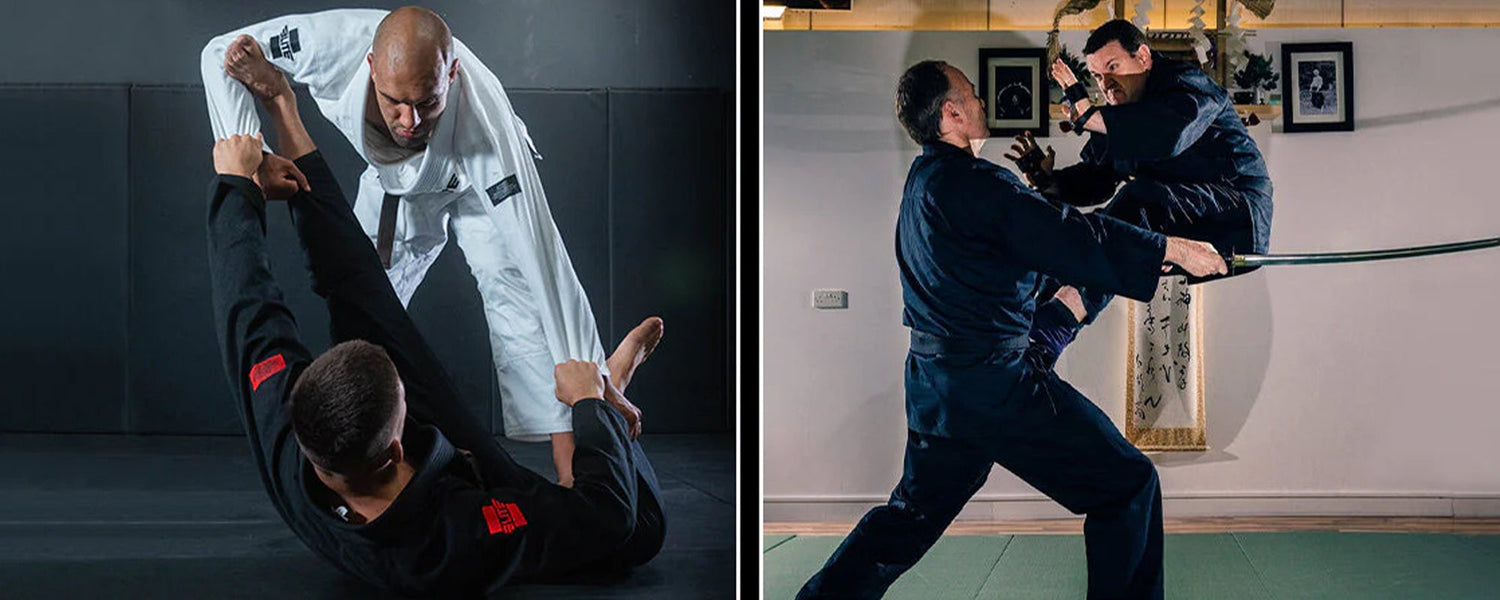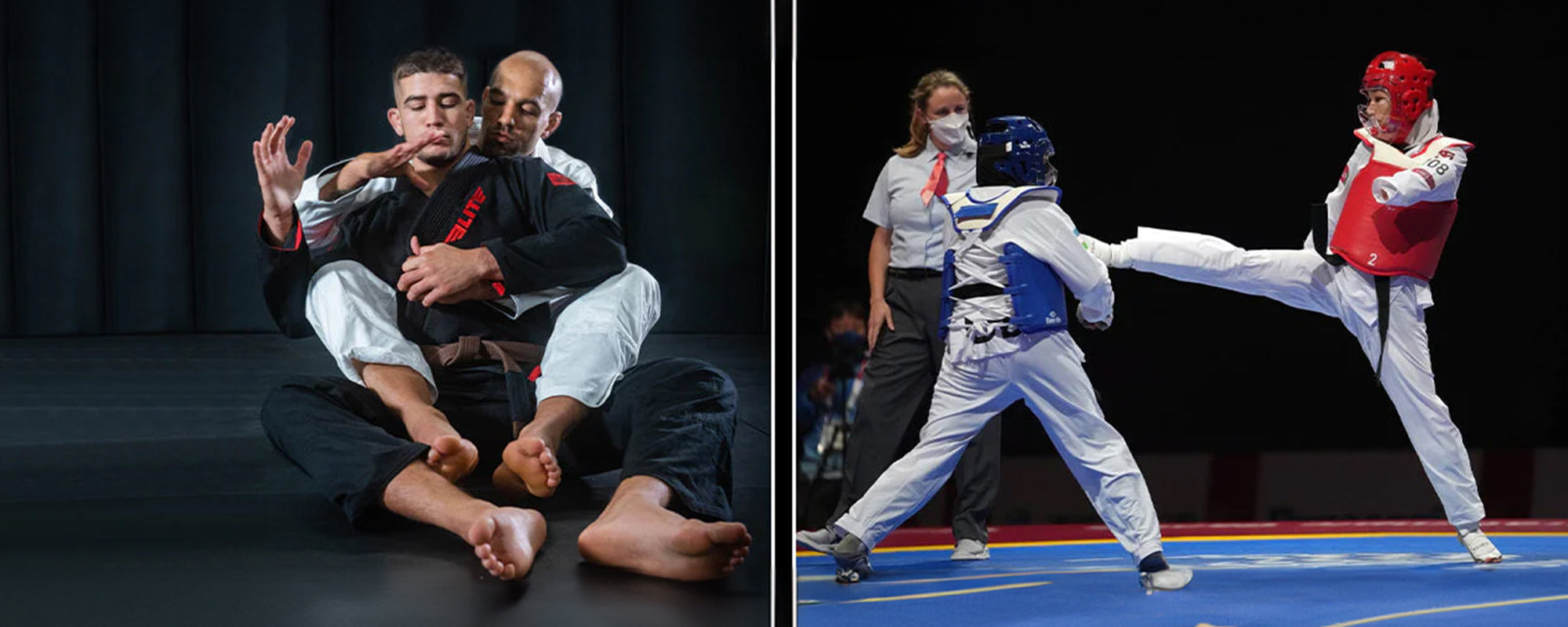Table of content
Jiu-Jitsu and Ninjutsu both are somewhat unique forms of martial arts. Jiu-Jitsu is based on ground fighting and grappling for getting submission holds and applying body locks while ninjutsu is based on punches, kicks, espionage, and strikes.
1. What is Jiu-Jitsu?
Jiu-Jitsu is a kind of self-defense martial art. It is based on body locks, submission techniques, and ground grappling combat. It teaches how to subdue an opponent, gain control by using the anatomy of the body, and use chokeholds to subdue them without punching, kicking, or throwing the opponent.
Jiu-Jitsu revolutionized grappling martial arts and gave rise to the popularity of MMA, which is the greatest martial art sport in the world.
Jiu-Jitsu encourages weight reduction, enhances muscular tone, and greater knowledge of human anatomy because it combines dynamic and explosive motions with joint lock-based techniques. Jiu-Jitsu also enhances your balance and reflex skills because, during the bout, your muscle memory will take over the fast and intense grappling.
Jiu-Jitsu is a fantastic martial art that involves cerebral exercise as well. In the beginning learning a new martial art with its many variants in techniques, tactics, and submissions is a struggle. Whether you are in a defensive or an advantageous position, your agile thinking, swift decision making and seamless execution combined with neural reflex response will play a crucial role in your win or defeat.
1.1. Jiu-Jitsu Positions and Submissions
The Mount
Mount is a basic and crucial position in which a player rests all weight on the opponent’s stomach. This technique is worth four points in Brazilian Jiu-Jitsu competitions. There are countless transition options possible from the Mount position. There are many variations in Mount like Rear Mount, (4 points) Mount, (4 points) Full Mount, Rear Mount, and Side Mount.
The Side Mount
A position where a player is on top of the opponent putting all body weight on him to make escape difficult. The side mount is an intermediate position before attempting to mount.
The Back Mount
A player grabs the opponent from behind with legs wrapped around his hips. You can easily choke your opponent in this position as he/she can’t see your next move.
The Guard
A position where a player wraps his legs around the opponent with his/her buttocks on the ground. There are three basic variations: open guard, closed guard, and half guard. This is the common position in Jiu-Jitsu and also opens the possibility of countless transitions.
North-South
A technique in which a player puts body weight on the opponent and pins his head and chest to the ground. This is like the side mount position but both players' legs face the opposite direction.
Scarf Hold
In this technique, a player sits next to his opponent with his back facing the side of their chest and then wraps his arm around the opponent's neck.
Knee On Belly
This is one of the most painful positions in Jiu-Jitsu, a player puts his body weight on the opponent’s stomach by using his knee. A successful knee on the belly will give 2 points.
2. What is Ninjutsu?
Ninjutsu is a Japanese martial art that originated in the feudal era of Japan. It is derived from the word “Ninja”, a group of people having powerful self-defense, fighting, and elite camouflage techniques.
Different variations of Ninjutsu like bijutsu, bojutsu, taijutsu, kenjutsu, and shurikenjutsu are being taught in Japanese schools. Ninjutsu is a unique art as it includes the customary footwork, punches, kicks, grips, strikes, and above all tranquility of mind and soul.
Overall, ninjutsu is an effective method for elite archaic martial art practitioners. However, there are several forms of ninjutsu, and each has its own set of techniques and skills, much like every other art. Each style will require a particular execution method and set of skills.
2.1. Ninjutsu Techniques
Taijutsu
Taijutsu teaches you self-defense mostly without using any weapon, you can use any part of your body to defend yourself.
Taijutsu will teach you chokes, throws, kicks, strikes, and offensive and defensive movements like leaping, rolling, and diving.
Bojutsu
In this technique, you will learn to use the staff known as “Bo”. Moreover, you will get to learn spinning, blocking, and striking techniques in Bojutsu.
Kenjutsu
In this technique, you will be taught how to use and handle swords in a fight. In addition to this, you will also get familiar with the positions like a sword held to the side, middle thrust, horizontal sword swipes, and sword pointing down.
Naginatajutsu
In this technique, you will get to know the usage of long-handled naginata to attack your opponent. You can increase the distance between you and your enemy with naginata by following the techniques like hook, batter, and stab.
Kusarigamajutsu
In this technique, you will learn to use a peculiar kusarigama, a traditional Japanese weapon having a chain attached to one end and iron weight carried by that chain on the other end.
3. Differences Between Jiu-Jitsu And Ninjutsu
Jiu-Jitsu and Ninjutsu have many comparable techniques. But there is one significant distinction between the two, Jiu-Jitsu relies on speed and momentum to knock the opponent off balance. On the other hand, Ninjutsu focuses on contemplation and intelligent movements. It aims to take advantage of the opponent's weaknesses.
Moreover, learning Jiu-Jitsu is easier and simpler than Ninjutsu, you can easily search for an expert to teach you Jiu-Jitsu.
| Jiu- Jitsu | Ninjutsu |
|---|---|
| Jiu-Jitsu is a kind of martial art based on grappling, submission, and ground fighting. | Ninjutsu is a kind of martial art based on punches, kicks, footwork, strikes, and grips. |
| Common positions in Jiu Jitsu are Mount, Guard, Side Mount, North-South, Scarf Hold, Back Mount, and Knee On Belly. | Common techniques in Ninjutsu are Taijutsu, Bojutsu, Kenjutsu, Naginatajutsu, Sojutsu, and Kusarigamajutsu. |
| Jiu Jitsu is based on the speed and momentum to knock off the opponent’s balance. | Ninjutsu aims to take advantage of the opponent’s weakness through intelligent movements. |
4. Benefits Of Jiu-Jitsu
4.1. Improves Mental Health
Brazilian jiu-jitsu training is a great approach to maintaining and developing our mental and physical health. There is a natural sense of advancement and fulfillment in the sport since it calls for ongoing development and growth.
Additionally, physical exercise as a whole is really effective for our mental health. Several pieces of research have shown that it lowers the risk of depression and increases our happiness.
4.2. Enhance Problem-Solving Skills
You will start to notice how Jiu-Jitsu techniques relate to the natural body structure of the human body as you get a deeper understanding of jiu-jitsu positions, movements, and submission techniques.
Brazilian jiu-jitsu is frequently contrasted with the strategy game chess. It's you vs someone else's mind, and both fighters’ moves are definitely influenced and guided by your mental agility, problem-solving skills, withstanding the pressure, and above all mental and physical stamina.
4.3. Self-Defense Skills
Jiu-Jitsu provides comprehensive training on effective self-defense techniques. Jiu-Jitsu fundamentals emphasize that closing the distance and controlling your opponent is the most effective technique for self-protection.
In reality, a number of law enforcement officials will complete specific courses that involve Jiu-Jitsu instruction, techniques, submissions, and methods. This is due to the fact that using Brazilian Jiu-Jitsu techniques is the recommended approach to defend in hazardous situations.
4.4. Stress Relief
When you come to practice Jiu-Jitsu, whatever issues are on your mind will be defused by the intensity and devotion Jiu-Jitsu demands throughout training. Different forms of exercise could provide some relief, but jiu-jitsu is an intense sport. This enables you to sparr and roll with qualified partners and instructors. Some people actually use Brazilian jiu-jitsu as therapy.
5. Benefits of Ninjutsu
5.1. Strengthen Coordination
Through ninjutsu training, you may improve your reflexes and coordination. The body's ability to react quickly and safely under uncertain situations is a significant focus of ninjutsu training.
5.2. Improves Mental Stamina
This ability focuses on mental calmness and wellness and builds self-discipline. You will get some knowledge of meditation in addition to physical fighting, which will eventually help you focus better and distract you from your worries.
The boundaries you have set for yourself may be expanded and stretched if you want to be diligent in such a rigorous and historic martial arts ninjutsu. Through regular practice, your body and mind may be stretched beyond what you previously believed was possible!
5.3. Can Help In Weight Loss
Ninjitsu may assist you in losing a few pounds quickly. Along with achieving the physique of your dreams, you will be able to lose those obstinate fats. Training Ninjutsu is not very hard but not easy as well, but rest assured that your current body shape will not limit your movement.
5.4. Increased Self-Confidence
Learning a new talent will inevitably increase your self-assurance. Your physique and self-esteem will both be improved by a talent like this. You'll be anticipating a whole spectrum of confident realms. Boosted confidence will prepare you to stand up to bullies.
5.5. Strengthen body muscles:
Ninjutsu requires a lot of movement of the body. Both the lower and upper zones of your body are included. Your flexibility will be increased to a whole new level, and your stamina will also improve.
Regular exercises make you primarily focus on weight lifting and improving physical appearance. Ninjutsu is keenly focused on enhancing and building the mind-muscle and prepares you to remain calm and focused in highly fluid situations.
6. Jiu-Jitsu vs Ninjutsu: Which Is Better For Self-defense?
Both teach different techniques for self-defense. For some, BJJ is more effective for self-defense as it teaches strong grappling skills and for some, Ninjutsu is better for self-defense than Jiu-Jitsu because it teaches both armed and unarmed fighting.
Additionally, it teaches a broad spectrum of skills, including espionage, pyrotechnics, a sense of geography and its importance in striking and defense, meteorology, water training for increasing focus and firm ground stance, swordsmanship, and throwing. The greatest defense is frequent escape, therefore practitioners acquire a broad variety of lethal physical tactics (weaponising the body) as well as strategies for confounding an opponent.
7. Jiu Jitsu vs Ninjutsu: Which Is Better?
Both Ninjutsu and BJJ are excellent combat techniques, neither is inherently superior to the other. Both have their own ideologies and are built for specific purpose oriented techniques and approaches.
Ninjutsu is a comprehensive martial art that teaches both armed and unarmed fighting. BJJ is a grappling martial art that teaches ground grappling methods focused on joint locks and choke holds.
BJJ is based on grappling, grips, submissions, and ground combat. Live sparring and rolling is a major component of BJJ training, allowing students to efficiently practice using their newly learned techniques.
Given that Ninjutsu teaches a broad spectrum of combat techniques, both armed and unarmed, it has a well-established set of lethal stealth techniques. This martial art cultivates one's physical, mental, and spiritual well-being by teaching all the necessary fighting techniques.
8. Final Words
Many techniques in Jiu-Jitsu are similar to Ninjutsu but the main difference between the two is, Jiu-Jitsu is based on ground combat without slamming and kicking while Ninjutsu is based on intelligent movements, clone techniques, substitution, walking on water, and body flickering techniques.
Photo Credit: @irishtimes












Leave a comment
This site is protected by hCaptcha and the hCaptcha Privacy Policy and Terms of Service apply.